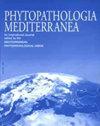葡萄灰皮诺病毒的分子分析及其与撒丁岛“Vermentino”葡萄藤叶斑和变形的关系
IF 1.9
3区 农林科学
Q2 AGRONOMY
引用次数: 0
摘要
2017年至2018年,意大利撒丁岛葡萄品种“Vermentino”感染葡萄灰皮诺病毒(GPGV),表现出马赛克、褪绿斑点和卷曲的叶片症状,并出现枝条发育不良。2018年评估的疾病发病率(67%,在监测的153株植物中有103株有症状)高于2017年(26%,在153株中有40株)。在这两年中,通过RT-PCR检测的所有有症状样本的GPGV均呈阳性,而2017年和2018年分别有70%(53/76)和42%(19/45)的无症状样本也呈GPGV阳性。通过RT-PCR对来自“Vermentino”的6个GPGV分离株进行表征,并对覆盖运动和外壳蛋白基因的基因组片段进行测序,在撒丁岛分离株和GenBank中有序列信息的分离株中显示出核苷酸水平的高度保守性(98.7%至100.0%)。系统发育分析表明,大多数撒丁岛GPGV分离株与其他欧洲分离株分组。这是首次在撒丁岛葡萄园中鉴定GPGV。本文章由计算机程序翻译,如有差异,请以英文原文为准。
Molecular analysis of grapevine Pinot gris virus and its association with grapevine leaf mottling and deformation on ‘Vermentino’ grapevines in Sardinia
In 2017–2018, grapevines of cultivar ‘Vermentino’ infected with grapevine Pinot gris virus (GPGV) in Sardinia, Italy, exhibited leaf symptoms of mosaic, chlorotic mottling, and curling, and stunted shoots. Disease incidence assessed in 2018 was greater (67%, 103 symptomatic plants out of 153 monitored) than in 2017 (26%, 40 of 153 plants). All symptomatic samples tested by RT-PCR were positive for GPGV in both years, while 70% (53 of 76) of the asymptomatic samples in 2017, and 42% (19 of 45) in 2018, were also positive for GPGV. Characterizing six GPGV isolates from ‘Vermentino’ by RT-PCR and sequencing of a genomic fragment covering the movement and coat protein genes showed high conservation at the nucleotide level (98.7% to 100.0%) among Sardinian isolates and isolates for which sequence information is available in GenBank. Phylogenetic analysis indicated that most Sardinian GPGV isolates grouped with other European isolates. This is the first characterization of GPGV in a Sardinian vineyard.
求助全文
通过发布文献求助,成功后即可免费获取论文全文。
去求助
来源期刊

Phytopathologia Mediterranea
生物-植物科学
CiteScore
4.40
自引率
8.30%
发文量
28
审稿时长
6-12 weeks
期刊介绍:
Phytopathologia Mediterranea is an international journal edited by the Mediterranean Phytopathological Union. The journal’s mission is the promotion of plant health for Mediterranean crops, climate and regions, safe food production, and the transfer of new knowledge on plant diseases and their sustainable management.
The journal deals with all areas of plant pathology, including etiology, epidemiology, disease control, biochemical and physiological aspects, and utilization of molecular technologies. All types of plant pathogens are covered, including fungi, oomycetes, nematodes, protozoa, bacteria, phytoplasmas, viruses, and viroids. The journal also gives a special attention to research on mycotoxins, biological and integrated management of plant diseases, and the use of natural substances in disease and weed control. The journal focuses on pathology of Mediterranean crops grown throughout the world.
The Editorial Board of Phytopathologia Mediterranea has recently been reorganised, under two Editors-in-Chief and with an increased number of editors.
 求助内容:
求助内容: 应助结果提醒方式:
应助结果提醒方式:


